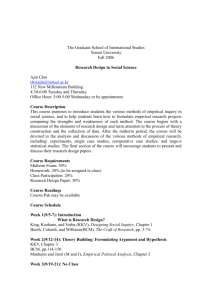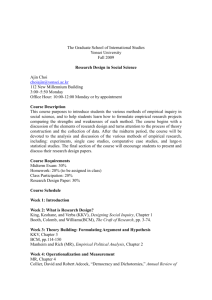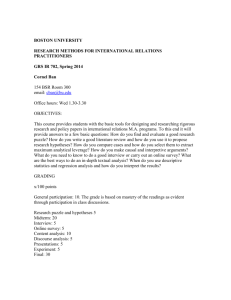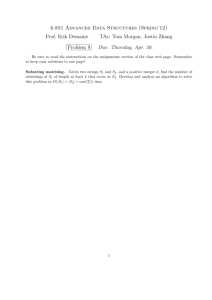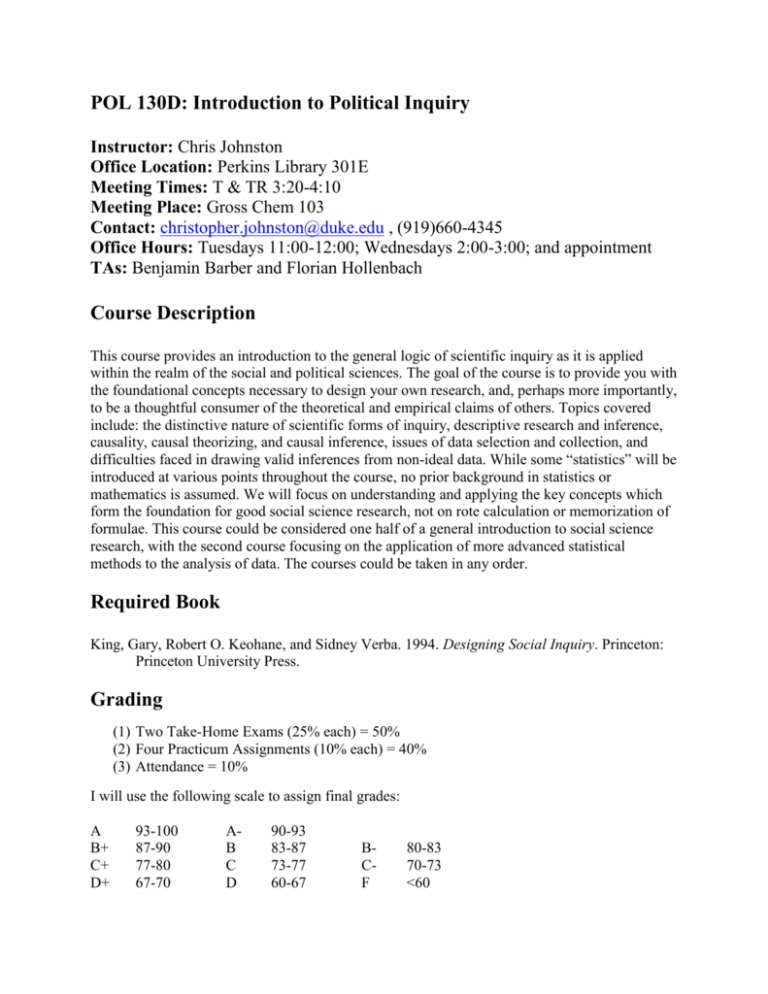
POL 130D: Introduction to Political Inquiry
Instructor: Chris Johnston
Office Location: Perkins Library 301E
Meeting Times: T & TR 3:20-4:10
Meeting Place: Gross Chem 103
Contact: christopher.johnston@duke.edu , (919)660-4345
Office Hours: Tuesdays 11:00-12:00; Wednesdays 2:00-3:00; and appointment
TAs: Benjamin Barber and Florian Hollenbach
Course Description
This course provides an introduction to the general logic of scientific inquiry as it is applied
within the realm of the social and political sciences. The goal of the course is to provide you with
the foundational concepts necessary to design your own research, and, perhaps more importantly,
to be a thoughtful consumer of the theoretical and empirical claims of others. Topics covered
include: the distinctive nature of scientific forms of inquiry, descriptive research and inference,
causality, causal theorizing, and causal inference, issues of data selection and collection, and
difficulties faced in drawing valid inferences from non-ideal data. While some “statistics” will be
introduced at various points throughout the course, no prior background in statistics or
mathematics is assumed. We will focus on understanding and applying the key concepts which
form the foundation for good social science research, not on rote calculation or memorization of
formulae. This course could be considered one half of a general introduction to social science
research, with the second course focusing on the application of more advanced statistical
methods to the analysis of data. The courses could be taken in any order.
Required Book
King, Gary, Robert O. Keohane, and Sidney Verba. 1994. Designing Social Inquiry. Princeton:
Princeton University Press.
Grading
(1) Two Take-Home Exams (25% each) = 50%
(2) Four Practicum Assignments (10% each) = 40%
(3) Attendance = 10%
I will use the following scale to assign final grades:
A
B+
C+
D+
93-100
87-90
77-80
67-70
AB
C
D
90-93
83-87
73-77
60-67
BCF
80-83
70-73
<60
Attendance Policy
Attendance is 10% of your final grade, and, in addition to ensuring you do well in the course, is
an easy way to get points. Success in this course will likely be difficult without regular
attendance. I will grade attendance as follows:
(1) TAs will take attendance in sections. There are 13 total section meetings during the
semester. You may miss 3 sections (for any reason) with no penalty. After 3, your section
attendance grade will decline by one letter grade for each section missed.
(2) I will pass around an attendance sheet for each lecture, and you will sign next to your
name. You may miss 5 lectures (for any reason) with no penalty. After 5, your lecture
attendance grade will decline by half a letter grade for each lecture missed.
(3) Your final attendance grade will be a simple average of (1) and (2).
Extra Credit
Extra credit will be given for participation in departmental research projects. Students may
participate in up to three hours of projects, earning one point on their FINAL grade for each
hour. Thus, each student may earn up to three points on their final grade. As this is fairly
generous, and requires minimal time investment and effort, no other extra credit will be given;
no exceptions (except the exception below), so please do not ask.
More information on this option is available at http://www.duke.edu/web/psrp. If you wish to
participate, you can register at: http://duke-psrp.sona-systems.com. Please direct all questions
regarding the PSRP to the site administrator, David Sparks, at d.sparks@duke.edu.
The only exception pertains to the first practicum assignment, which entails making a forecast
for the 2012 Presidential Election. The student (or students in the case of a tie) with the best
forecast will receive a prize of 1 extra credit point on his or her final grade. “Best” will be
defined as the forecast closest to the actual value in absolute terms (see below for more
information).
Policy
I will follow Duke University’s procedures to establish whether absences from any event related
to this class are justified (e.g. illness, sport events) and merit ad hoc arrangements. Other than in
the very restrictive cases contemplated by the university, make up exams are not an option. Late
assignments will be reduced by one full letter grade for each day beyond the deadline.
I will also follow the University’s policy in any event of plagiarism and academic dishonesty.
Grade complaints: You have the right to dispute a grade if you disagree with it. You must do so
in writing, no more than 3 working days after we have returned the exam/paper to you. Upon
receiving your appeal, I will reevaluate your grade. Please note that I will reevaluate the entire
assignment. Thus, if we have made an error in your favor, this will also be corrected.
Practicum Assignments
You are required to complete four practicum assignments that are intended to reinforce what you
learn in lecture through application to real problems in political science. Time has been allotted
to sections for developing skills relevant to these projects, and to working on them, and you
should take advantage of this. Your TAs will be a great resource for these assignments. A
description of each assignment is given below, and we will discuss each further in class and in
sections.
Assignment 1: Forecasting the 2012 Presidential Election
Your first assignment, corresponding with the Descriptive Inference section of the course, is to
generate a forecast for the 2012 Presidential Election. More specifically, you are to generate a
prediction of the difference in the proportion of the popular vote won by Obama versus Romney.
In other words, if p = the proportion of the popular vote won by Obama, and q = the proportion
of the popular vote won by Romney, you want to generate an estimate of (p – q). You should
also generate an uncertainty bound for your estimate. Finally, on the basis of your estimate and
uncertainty calculations, you should estimate the probability that Obama will win the popular
vote (i.e., that (p – q) > 0). You should use publically available polling data to generate your
estimate, and you may utilize these data any way you choose. You will be graded on your
justification for your choices as well as your calculations.
You will turn in, to be graded:
(1)
(2)
(3)
(4)
A short paper describing what you did and why
Any data you used to generate your estimate (i.e. the raw values)
Any calculations you performed to obtain your estimate
The final forecast with an uncertainty estimate for that value, and probability of victory
You MAY NOT:
(1) Use a single, previously published forecast as your forecast (e.g., Nate Silver’s at the
NYT)
(2) Use a single, political prediction market to generate your forecast (e.g., the price of
Obama winning the election on InTrade)
(3) Copy someone else’s procedure within the class. You MAY discuss any problems or
theoretical issues in sections, with classmates, with me, and with TAs. The end product,
however, must be a result of your own efforts (e.g., data collection, calculations, paper
write-up, etc.). Note that you need to justify what you did in the paper. If you do not
understand what you did and why, this will be apparent in your write-up.
As an added incentive to do your best, the person with the “best” forecast in each section will
receive 1 point extra credit on his or her final grade for the course. “Best” will be defined as the
forecast closest (in absolute terms) to the actual difference in proportions.
Assignment 2: Estimate the Effect of One Variable on Another
Your second assignment is to estimate the causal effect of one variable on another. In other
words, your goal is to generate an estimate of what happens to some dependent variable as some
independent variable changes values. You will be graded both on execution (proper use of data,
calculations, etc.) and your justification for claiming that your estimate is a “good” one. Note
here the importance of referring to our discussions in class. If there are limitations to the
inferences you can justifiably make, you should discuss these. You may choose any question or
problem you wish. The only restriction is, as always, that you do your own work.
You will turn in, to be graded:
(1)
(2)
(3)
(4)
A short paper describing what you did, why you did it, and a theoretical discussion
Any data you used to generate your estimate (i.e. the raw values)
Any calculations you performed to obtain your estimate
The final estimate (the estimate of the causal effect) with an uncertainty estimate for that
value
Assignment 3: Critical Analysis of a Published Research Design
For your third assignment, you will utilize our discussions in class and sections to critically
evaluate the research design of a published research article (of my choosing). Your goal is to
identify any problems with the design, and the broader implications of those problems for
making valid inferences about the parameter of interest to the authors. You will be graded on the
cogency of your arguments.
You will turn in, to be graded:
(1) A 2-4 page paper critically assessing the research design of the article
Assignment 4: Design a Study to Test a Hypothesis
For your final assignment, you will design a study to test a hypothesis of your choosing. In this
case (in contrast to Assignment 2), you must explicitly address problems of causal inference and
their potential solutions. We will discuss these in class. You may test any hypothesis you wish,
and you may test that hypothesis any way you wish. You will be graded on the logic of your
research design, and the cogency of your arguments for why your design is a valid test of your
hypothesis. The only restriction is, as always, that you do your own work.
You will turn in, to be graded:
(1) A 3-5 page paper which introduces your question, states your hypothesis, and describes
your research design and its justification.
Course Outline
8/28: Course Introduction and Syllabus
8/30: NO CLASS
8/30 and 8/31: NO SECTIONS
Why Political Science?
9/4: Why Political Science?
Watts, Duncan. 2011. “The Myth of Common Sense.”
Nyhan, Brendan. 2012. “Do Campaign Gaffes Matter? Not to Voters.”
Listen/Watch: Haidt, Jonathan. 2011. “The Bright Future of Post-Partisan Social Psychology.”
9/6: What Makes Political Science Science?
KKV: Preface & Chapter 1, pp. 3-12
Gerber, Alan S., Donald P. Green, and Christopher W. Larimer. 2008. “Social Pressure and
Voter Turnout: Evidence from a Large-Scale Field Experiment.” American Political
Science Review 102 (1): 33-48.
9/6 and 9/7: Sections
Introductions with TAs
9/11: What Political Scientists Do (Or Should Do)
KKV: Chapter 1, pp. 12-28
9/13: Recent Attacks on (Political) Science
“Amendment Offered by Mr. Flake.” Congressional Record of the U.S. House of
Representatives, 5/9/2012, pgs. H2543-H2544.
Stapel and Data Falsification
Stevens, Jacqueline. 2012. “Political Scientists are Lousy Forecasters.”
Watch: Krosnick on “Trust in Science”
9/13 and 9/14: Sections
Discussion of NSF debate, scientific integrity, etc.
Descriptive Inference
9/18: On the General and the Particular
KKV: Chapter 2, pp. 34-49
Petrocik, John R. 2009. “Measuring Party Support: Leaners are not Independents.” Electoral
Studies 28: 562-572.
9/20: Data Collection, Summary, and Statistics
KKV: Chapter 2, pp. 49-55
9/20 and 9/21: Sections
Work on Assignment 1 with TAs; collecting and organizing data from the internet
9/25: Random Variables
KV: Chapter 2, pp. 55-63
9/27: Uncertainty and Its Interpretations
KV: Chapter 2, pp. 55-63
Green, Donald P., and Bradley Palmquist. 1990. “Of Artifacts and Partisan Instability.”
American Journal of Political Science 34 (3). Read only 872-881.
9/27 and 9/28: Sections
Work on Assignment 1 with TAs; calculating uncertainty bounds for estimates
10/2: Unbiasedness
KV: Chapter 2, pp. 63-65
Erikson, Robert S., and Kent L. Tedin. 2007. “Bad Sampling: Two Historical Examples.” In
American Public Opinion, 7th edition, Robert S. Erikson and Kent L. Tedin (Eds.). New
York: Pearson Longman. (On Sakai)
10/4: Efficiency and Mean Squared Error
KKV: Chapter 2, pp. 66-74
10/4 and 10/5: Sections
Work on Assignment 1 with TAs; questions and help
Causal Inference
10/9: Counterfactuals and Causality
KKV: Chapter 3, pp. 75-85
Gelman, Andrew, and Jennifer Hill. 2007. Data Analysis Using Regression and
Multilevel/Hierarchical Models. Chapter 9, pages 167-173.
10/11: Causal Effects and Causal Uncertainty
KKV: Chapter 3, pp. 75-85
Fox, Richard L., and Zoe M. Oxley. 2003. “Gender Stereotyping in State Executive Elections:
Candidate Selection and Success.” The Journal of Politics 65 (3): 833-850.
10/11 and 10/12: Sections
Work on Assignment 2 with TAs; obtaining and organizing publically available data
TURN IN ASSIGNMENT 1
10/16: FALL BREAK
10/18: Assumptions for Estimating Causal Effects
KKV: Chapter 3, pp. 91-97
10/18 and 10/19: Sections
Review for exam
TAKE-HOME EXAM RELEASED ON 10/19 AFTER LAST SECTION
10/23: Unbiasedness and Efficiency for Causal Effects
KKV: Chapter 3, pp. 97-99
TAKE HOME EXAM DUE AT BEGINNING OF CLASS
10/25: Constructing Good Causal Theories
KKV: Chapter 3, pp. 99-114
Tversky, Amos, and Daniel Kahneman. 1981. “The Framing of Decisions and the Psychology of
Choice.” Science 211: 453-458.
10/25 and 10/26: Sections
Work on Assignment 2 with TAs; calculation of uncertainty bounds; other help
Selecting Observations for Study
10/30: Indeterminacy and Its Sources
KKV: Chapter 4, pp. 115-124
11/1: The Ideal of Random Selection
KKV: Chapter 4, pp. 124-128
11/1 and 11/2: Sections
Examples and discussion of observation-selection methods and their advantages/disadvantages
TURN IN ASSIGNMENT 2
11/6: Types of Selection Bias and Their Implications
KKV: Chapter 4, pp. 128-139
Wiblin, Robert. 2012. “Middle-Aged Not Miserable, Just Too Busy to Answer Surveys.”
11/8: Intentional Selection
KKV: Chapter 4, pp. 139-50
He, Kai. 2013. “Case Study and the Comparative Method: Why Do States Join Institutions?” In
Political Science Research in Practice, Akan Malici and Elizabeth S. Smith (Eds.). New
York: Routledge.
11/8 and 11/9: Sections
Critiquing research designs, examples and discussion
Making Good Inferences
11/13: Measurement and Measurement Error
KKV: Chapter 5, pp. 150-168
11/15: Implications of Measurement Error
KKV: Chapter 5, pp. 150-168
Sullivan, John L., James Piereson, and George E. Marcus. 1979. “An Alternative
Conceptualization of Political Tolerance: Illusory Increases 1950s-1970s.” American
Political Science Review 73 (3): 781-794.
11/15 and 11/16: Sections
Work on Assignment 4 with TAs; issues of measurement with examples
TURN IN ASSIGNMENT 3
11/20: THANKSGIVING BREAK
11/22: THANKSGIVING BREAK
11/27: Spuriousness and Omitted Variable Bias
KKV: Chapter 5, pp. 168-185
11/29: The Logic of Control
KKV: Chapter 5, pp. 168-185
Levitt, Steven D., and James M. Snyder Jr. 1997. “The Impact of Federal Spending on House
Election Outcomes.” The Journal of Political Economy 105 (1): 30-53.
11/29 and 11/30: Sections
Work on Assignment 4 with TAs; questions and help
12/4: Endogeneity and “Reverse Causality”
KKV: Chapter 5, pp. 185-196
12/6: Control through Random Assignment (i.e. Experimentation)
KKV: Chapter 5, pp. 196-208
Druckman, James N., Donald P. Green, James H. Kuklinski, and Arthur Lupia. 2006. “The
Growth and Development of Experimental Research in Political Science.” American
Political Science Review 100 (4): 627-635.
12/6 and 12/7: Sections
Review for Final Exam
HAND IN ASSIGNMENT 4

